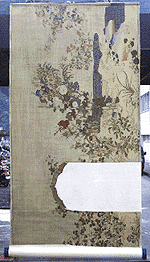Jinbe Kawashima
|
 Born into the Ueda family of draperies, Kawashima inherited the family business in 1879 and specialized in textile dyeing. In 1884, he established the Kawashima Textile Factory and improved on traditional weaving methods such as "Tango Chirimen" (silk crepe made in Tango), "Karanishiki" (Chinese brocade), and a style of patterned weaving called "Tsuzure Ori." In 1886, he left for Europe with Yasaburo Shinagawa to introduce Japanese artistic weaving techniques and to study European weaving techniques, such as the French Gobelins style. Upon his return to Japan a year later, he produced a number of works which utilized the special characteristics of the Gobelins technique. In 1905, Kawashima produced his most outstanding work, "Hyakka Hyakucho" (A hundred flowers and a hundred birds), which was exhibited at the Liege International Exposition in Belgium. In 1909, he invented the dual surfaced Tuzurinishiki style of weaving and exhibited "Hyakkiku Byobu" (Folding Screen of a Hundred Chrysanthemums) in a Japanese-British Exhibition. Kawashima was a truly outstanding individual who produced many fine works of art, which have found their way to the four corners of the globe.
Born into the Ueda family of draperies, Kawashima inherited the family business in 1879 and specialized in textile dyeing. In 1884, he established the Kawashima Textile Factory and improved on traditional weaving methods such as "Tango Chirimen" (silk crepe made in Tango), "Karanishiki" (Chinese brocade), and a style of patterned weaving called "Tsuzure Ori." In 1886, he left for Europe with Yasaburo Shinagawa to introduce Japanese artistic weaving techniques and to study European weaving techniques, such as the French Gobelins style. Upon his return to Japan a year later, he produced a number of works which utilized the special characteristics of the Gobelins technique. In 1905, Kawashima produced his most outstanding work, "Hyakka Hyakucho" (A hundred flowers and a hundred birds), which was exhibited at the Liege International Exposition in Belgium. In 1909, he invented the dual surfaced Tuzurinishiki style of weaving and exhibited "Hyakkiku Byobu" (Folding Screen of a Hundred Chrysanthemums) in a Japanese-British Exhibition. Kawashima was a truly outstanding individual who produced many fine works of art, which have found their way to the four corners of the globe. |
|

